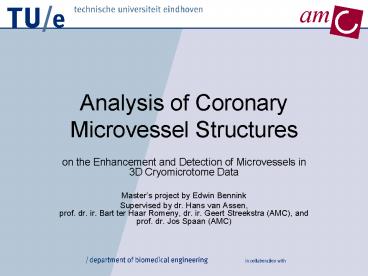Analysis of Coronary Microvessel Structures PowerPoint PPT Presentation
1 / 35
Title: Analysis of Coronary Microvessel Structures
1
Analysis of Coronary Microvessel Structures
- on the Enhancement and Detection of Microvessels
in 3D Cryomicrotome Data - Masters project by Edwin Bennink
- Supervised by dr. Hans van Assen,
prof. dr. ir. Bart ter Haar Romeny,
dr. ir. Geert Streekstra (AMC), and
prof. dr. Jos Spaan (AMC)
2
The Cryomicrotome
- Coronary arteries of a goat heart are filled with
a fluorescent dye - Cryo The heart is embedded in a gel and frozen
(-20C) - Microtome The machine images the samples
surface, scrapes off a microscopic thin slice
(40 µm), images the surface, and so on
a.
b.
3
Cryomicrotome Images
- Very high resolution about 404040 µm
- Continuous volume
- Huge stacks (billions of voxels, millions of
vessels) - Strange PSF in direction perpendicular to slices
- Scattering
- Broad range of vessel sizes and intensities.
8 cm 2000 pixels
4
Process Overview
- Sample preparation and imaging
- Microvascular tree modeling
- Preprocessing
- Limiting dark current noise
- Canceling transparency artifacts.
- Enhancement of line-like structures
- Binarization and skeletonization
- Extraction of nodes and edges
- Measuring the diameters along the edges
- Postprocessing.
- Analysis and simulations on digitized
microvascular trees.
5
Limiting dark current noise
- Dark current noise
- arises from thermal energy in the CCD
- is additive noise
- is measured with a closed shutter
- is CCD-specific and nearly constant over time
- can be removed from images by subtraction.
6
Original data
7
Dark current noise
8
Noise subtracted from data
9
Canceling transparency artifacts
Point-spread function in z-direction (perpendicula
r to slices)
10
Canceling transparency artifacts
Point-spread function in z-direction (perpendicula
r to slices)
11
Canceling transparency artifacts
Point-spread function in z-direction (perpendicula
r to slices)
12
Canceling transparency artifacts
Point-spread function in z-direction (perpendicula
r to slices)
13
Canceling transparency artifacts
Point-spread function in z-direction (perpendicula
r to slices)
14
Canceling transparency artifacts
- The effect of transparency is theoretically a
convolution with an exponent - s denotes the tissues transparency.
f(z)
1
0.8
0.6
0.4
0.2
z
-
-
-
6
4
2
2
4
15
Canceling transparency artifacts
- In the Fourier domain
- The solid line is the real part, the dashed line
the imaginary part.
16
Canceling transparency artifacts
- Solution to the problem embed this property in
the (Gaussian) filters by division in the Fourier
domain - Multiplication is convolution, thus division is
deconvolution.
17
Canceling transparency artifacts
- The new 0th order Gaussian filter k(z) (in
z-direction) becomes
k
(z)
0.5
0.4
0.3
0.2
0.1
z
-
-
4
2
2
4
18
Canceling transparency artifacts
Default Gaussian filters
Enhanced Gaussian filters
z
x
19
Enhancement of line-like structures
- Datasets have dimensions over 20003 (the new
cryomicrotome images even 40003 voxels) - The filters are Gaussian, thus separable
- Read an x-y slice and filter in x and y
direction - Read some x-z slices and filter in z direction.
2000 pixels
2000 pixels
2000 tiff-files
20
Enhancement of line-like structures
- Lineness filter is based on
- Eigen values and vectors of Hessian matrix
- First order derivatives
- Transparency deconvolution is embedded in the
filter kernels
21
Enhancement of line-like structures
Edge surpression (gradient magnitude)
Intensity independence
Roundness (ratio between 2nd order derivatives
perpendicular to the linear structure)
Optimal 2nd order line filter (hotdog shaped
kernel)
22
Enhancement of line-like structures
- Take the maximum of the filter response over a
range of small scales (up to 160 µm) - The larger vessel can be extracted using a high
threshold value (on a slightly blurred, thus PSF
corrected stack).
23
Enhancement of line-like structures
- Microvessel Analyzer
- application
- Capable of filtering large stacks in a relative
short time...
24
Original data MIP of 100 slices
25
Filtered on 40 µm MIP of 100 slices
26
Filtered on 80 µm MIP of 100 slices
27
Filtered on 160 µm MIP of 100 slices
28
Binarization and skeletonization
- Extraction of vessel centerlines using
skeletonization - K. Palágyi and A. Kuba defined 333 templates
for parallel 3D skeletonization.
29
To do Validation study on filtered and
skeletonized vascular trees
- Comparison with other popular filters
- 2th or higher order line filters
- Frangis vessel likeliness function
- Stegers center line detector.
30
To do Validation study on filtered and
skeletonized vascular trees
Original data (normal and log-scale) (The images
are inverted)
31
2nd order line-filter
Frangis vessel-likeliness
Stegers center- line detector
Lineness measure
32
250
250
250
200
200
200
150
150
150
100
100
100
50
50
50
0
0
0
0
50
100
150
200
250
0
50
100
150
200
250
0
50
100
150
200
250
250
250
250
200
200
200
150
150
150
100
100
100
50
50
50
0
0
0
0
50
100
150
200
250
0
50
100
150
200
250
0
50
100
150
200
250
33
Multi-scale response Frangis Vessel Likeliness
Filter
250
0.8
200
0.6
150
0.4
100
0.2
50
50
100
150
200
250
0
0
50
100
150
200
250
34
250
250
250
200
200
200
150
150
150
100
100
100
50
50
50
0
0
0
0
50
100
150
200
250
0
50
100
150
200
250
0
50
100
150
200
250
250
250
250
200
200
200
150
150
150
100
100
100
50
50
50
0
0
0
0
50
100
150
200
250
0
50
100
150
200
250
0
50
100
150
200
250
35
Multi-scale responseLineness filter
250
1.4
1.2
200
1
150
0.8
0.6
100
0.4
0.2
50
50
100
150
200
250
0
0
50
100
150
200
250

